
|
The
most frequently seen animals on Ujjain coins are the bull, elephant, horse
and lion, which occupied important places in the daily life
and artwork of the people of India throughout the ages. The rich
coinages of Ujjain present these animals sometimes in a simple form, in
other cases in artistically high grade executions. Before
opening the coin gallery a few words may be said on the symbolism and
the extended meaning these animals carry.
BULL: The bull's
domestication
was an important step in the agricultural development of most ancient
societies. In the case of India outstanding depictions of bulls had
been engraved in prehistoric time on rocks and caves and later
during the third and early second millenium BCE in outstanding form
on many objects from Indus valley
civilisation sites such as Mohenjo-Daro and Harappa. On early Indian
coins, i.e. on some Mauryan karshapanas and certain local Deccan
punchmarked types, we find the interesting depiction of yoked bulls
drawing a ploughshare. The bull's vital role for human
society, its strength, fertility and power soon raised it into a
mythical and religious
context. Best known and well documented is the bull's association
with the Hindu god Shiva serving as this god's vahana (mount) in the
form of the magnificent bull Nandi, the son of Surabhi and Kasyapa.
Its inclusion into religious and divine spheres soon secured the bull and
cattle in general special respect, adoration and inviolability in Hindu society.
On the
coins of ancient Ujjain the bull is mostly standing or walking to the
right. Characteristically there are some associated symbols placed
above the animal, among which the svastika, taurine, Indradhvaja,
six-armed symbol, chakra or Ujjain symbol are the most frequently
encountered, whereas other symbols such as vase or three-arched hill
are rarely seen in association with the bull. In many instances the
bull is facing a railed tree or very occasionally a railed yupa which is placed on
the right.
ELEPHANT: The
elephant was adored by Buddhists, Hindus and Jains. Even if the white elephant
Airavata is mentioned as having been ridden by thunderbolt-wielding Indra it cannot be taken
as Indra's vahana in the same close association as the bull is linked to
Shiva. Indra rides Airavata when defeating
Vrta, who appears as a dragon or huge snake causing drought by blocking the course of
the rivers. Airavata sucks up the waters of the underworld and sprays
them into the clouds, so that Indra can cause them to rain down thus ending the terrible drought
on earth. This mythical story also emphasizes the elephant's close link to water and rain which is amply
illustrated in abisheka depictions of elephants anointing the goddess
Lakshmi. The elephant was used as a pack-animal and abused as a devastating weapon of war and in
its power and matchless strength regarded as a symbol of royal
authority. Its grandeur and noble character impressed people throughout
the ages and diverse cults developed around it. One amongst many others
is the famous story of Buddha entering the whomb of his mother Maya in
his last incaarnation in the form of a white elephant.
LION: The outstanding
position of
the lion in Indian life, culture and art is vividly illustrated by the
national Indian emblem, an adaptation of the lion capital of Ashoka at
Sarnath (near Varanasi in UP) which is crowned by four lions standing
on an abacus decorated with a frieze depicting an elephant, horse, lion
and bull. In Buddhism lions are depicted as dharma protectors
supporting the throne of lord Buddha and of bodhisattvas (followers of Buddha striving for enlightenment) - symbolizing
consistency, strength and wisdom. In Hindu mythology the lion appears
as one of the avatars (personifications) of the god Vishnu. There was no threat and no enemy the 'king of
the animals' had to fear and hence the lion's majesty and royalty are
easily understandable attributes.
HORSE: The very important role
the domesticated horse has always played in human society is
self-evident. Horses, sometimes with wings and sometimes
without, also had their parts in the myths of people all over the
world. Uchchaihshravas, the legendary white, winged horse of Hindu
mythology emerged from the ocean and was taken into heaven by Indra. Having removed its
wings to prevent it from flying away Indra presented the horse to mankind. Speed, freedom, grace and
beauty are attributes that immediately come to mind when thinking of
horses. Depictions of horses drawing a chariot are known but extremely
rare on coins of ancient India. There are 'horse type' coinages like
the Malayaman, the Hiranjaka or the Suktimati coins where the horse
occupies the dominant and largest element of the coin design. On the coins of
Ujjain, however, the horse is rather a coequal part of a multi-symbol
design.
Even a short
comment on
horses on Indian coins cannot conclude without mentioning
the Vedic Ashvameda (horse-sacrifice) ritual. This unusual ceremony was
the exclusive privilege of a king and was performed to celebrate a great victory or other very
special event. The stallion, carefully chosen from the flock of the king, was set free
to roam around for the time of one year during which it was followed by the king's army.
Then the horse was brought back to the king's residence and the
ceremony was performed. In its course the horse was tied to a
sacrifical post and after a
series of different
rites, in which a great number of diverse animals were involved,
the horse was
slaughtered. Only very few ancient Indian kings such as Pushyamitra
Sunga and Samudragupta are historically documented to have performed
the Ashvameda ceremony and in the case of Samudragupta some famous gold
coins bear witness to this event. Other claims to Ashvameda
depictions on ancient Indian coins are mostly unbased or at least too
unspecific to be sure about the depicted scene.
|
 |
UJJAIN, bull types
|
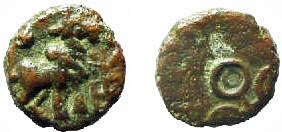
|
Ujjain, anonymous AE 1/12 karshapana, bull type
Weight: 0.68 gm., Diameter: 8 mm.
Obv.: Bull to right, taurine above, railed tree on right.
Rev.: Double-orbed Ujjain symbol.
Reference: Pieper 324 (plate specimen)
|
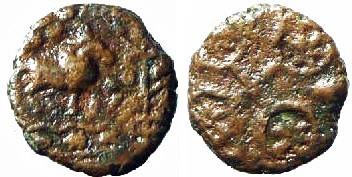
|
Ujjain, anonymous AE 1/6 karshapana, bull type
Weight: 1.49 gm., Diameter: 11mm mm.
Obv.: Bull to right, chakra above, railed tree on right, river below.
Rev.: Ujjain symbol with a shrivatsa in each orb.
Reference: Pieper 323 (plate specimen)
|
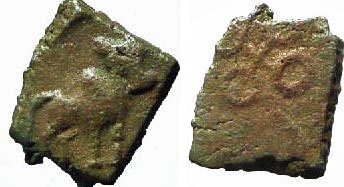
|
Ujjain, anonymous AE 1/8 karshapana, bull type
Weight: 1.14 gm., Diameter: 10x8 mm.
Obv.: Bull to right.
Rev.: Ujjain symbol.
Reference: Pieper 327 (plate specimen)
|
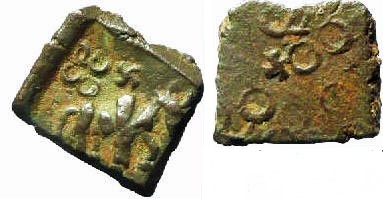
|
Ujjain, anonymous AE 1/8 karshapana, bull type
Weight: 0.95 gm., Diameter: 10x9 mm.
Obv.: Bull to right, Ujjain symbol and svastika above.
Rev.: Multiple Ujjain symbols, svastika in field.
Reference: Pieper 328 (plate specimen)
|

|
Ujjain, anonymous AE 1/12 karshapana, bull type
Weight: 0.75 gm., Diameter: 10x9 mm.
Obv.: Bull to right, svastika flanked by two taurines on top; taurine
on right.
Rev.: Ujjain symbol with a taurine in each angle.
Reference: Pieper 329 (plate specimen)
|

|
Ujjain, anonymous AE 1/16 karshapana, bull type
Weight: 0.62 gm., Diameter: 8x8 mm.
Obv.: Bull to right, svastika, Indradhvaja and taurine on top.
Rev.: Double-orbed Ujjain symbol.
Reference: Pieper 330 (plate specimen)
|

|
Ujjain, anonymous AE 1/8 karshapana, bull type
Weight: 0.85 gm., Diameter: 11x10 mm.
Obv.: Bull to right, svastika, taurine and Indradhvahja on top.
Rev.: Ujjain symbol with a taurine in each angle.
Reference: Pieper 331 (plate specimen)
|

|
Ujjain, anonymous AE 1/ 12 karshapana, bull type
Weight: 0.72 gm., Diameter: 9x8 mm.
Obv.: Bull to right, Ujjain symbol, vertical line and vase on top.
Rev.: Double-orbed Ujjain symbol.
Reference: Pieper 332 (plate specimen)
|
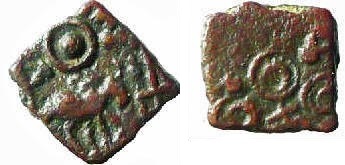
|
Ujjain, anonymous AE 1/ 12 karshapana, bull type
Weight: 0.69 gm., Diameter: 9x8 mm.
Obv.: Bull to right with two taurines above; dotted circle on top.
Rev.: Double-orbed Ujjain symbol with a taurine in each angle.
Reference: Pieper 334 (plate specimen)
|
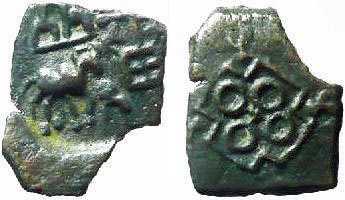
|
Ujjain, anonymous AE 1/8 karshapana, bull type
Weight: 0.83 gm., Diameter: 12x10 mm.
Obv.: Bull to right with three-arched hill above and taurine on right;
railed tree on right.
Rev.: Ujjain symbol enclosed in 'hollow cross' with a taurine in each
angle of the cross.
Reference: Pieper 336 (plate specimen)
|

|
Ujjain, anonymous AE 1/6 karshapana, bull type
Weight: 1.47g, Diameter: 11x8mm
Obv.: Bull to right with long horns bent forwards; railed tree on right.
Rev.: Ujjain symbol.
Reference: Pieper 337 (plate specimen)
|

|
Ujjain, anonymous AE 1/6 karshapana, bull type
Weight: 1.62 gm., Diameter: 11x8 mm.
Obv.: Bull to right with six-armed symbol above and railed tree on right.
Rev.: Ujjain symbol.
Reference: Pieper 335 (plate specimen)
|
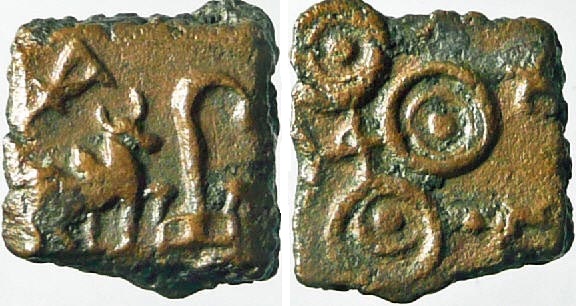
|
Ujjain, anonymous AE 1/6 karshapana, bull type
Weight: 1.37 gm., Diameter: 11x10 mm.
Obv.: Bull to right with Indradhvaja above; railed yupa (sacrifical post)
on right.
Rev.: Double-orbed Ujjain symbol.
Reference: Pieper 333
|
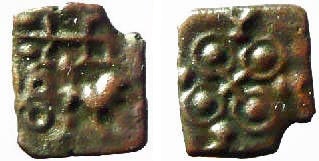
|
Ujjain, anonymous AE 1/ 16 karshapana, bull type
Weight: 0.52 gm., Diameter: 9x8 mm.
Obv.: Bull to left with Ujjain symbol above, railed tree on right.
Rev.: Ujjain symbol with thick dot inside each orb and a taurine in each
angle.
Reference: Pieper 339 (plate specimen)
|
 |
This is one of the few types of Ujjain on which the bull is standing to the left.
|

|
Ujjain, anonymous AE 3/8 karshapana, bull +tree type
Weight: 3.38 gm., Diameter: 15x15 mm.
Obv.: Bull to right facing railed tree on right; Indradhvaja and taurine
above the bull.
Rev.: Ujjain symbol
Reference: Pieper collection (compare type 340)
|

|
Ujjain, anonymous AE 3/8 karshapana, bull + tree type
Weight: 3.52 gm., Diameter: 17x15 mm.
Obv.: Bull to right facing railed tree on right; Indradhvaja flanked by
two taurines above the bull.
Rev.: Ujjain symbol with a dot in each orb.
Reference: Pieper 340 (plate specimen)
|
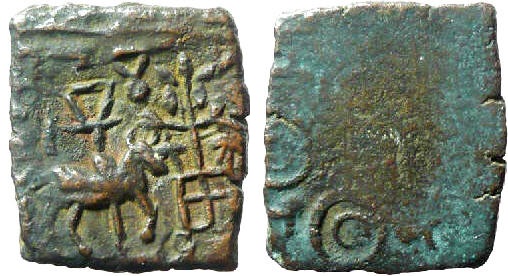
|
Ujjain, anonymous AE 1/2 karshapana, bull + tree type
Weight: 4.26 gm., Diameter: 17x15 mm.
Obv.: Bull to right facing a railed tree on right; Indradhvaja and taurine
above the bull.
Rev.: Double-orbed Ujjain symbol.
Reference: Pieper 341 (plate specimen)
|
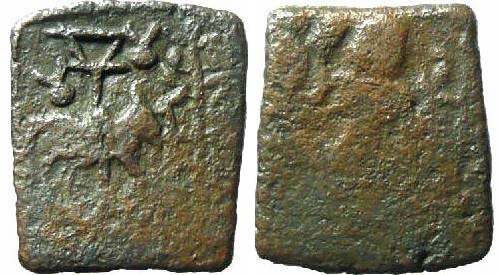
|
Ujjain, anonymous AE 1/2 karshapana, bull + tree type
Weight: 3.72 gm., Diameter: 17x15 mm.
Obv.: Bull to right facing a railed tree on right; Indradhvaja flanked by
two taurines above the bull.
Rev.: Worn undertype of Ujjain type 'vase-holding deity (Anapurna)
Reference: Pieper 342 (plate specimen)
|

|
Ujjain, anonymous AE 3/8 karshapanaa, bull + tree type
Weight: 3.32 gm., Diameter: 16x12 mm.
Obv.: Bull to right facing its head towards the viewer with taurine and
svastika above and another svastika in front of the bull; railed tree
on right; river at the bottom.
Reference: Pieper 343 (plate specimen)
|
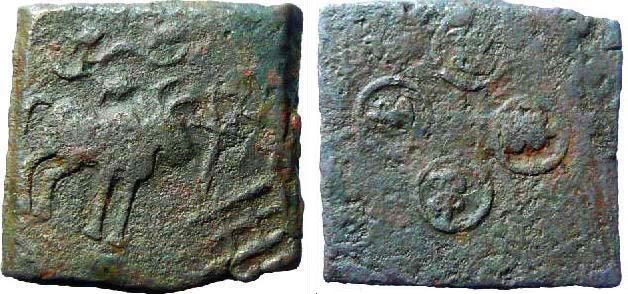
|
Ujjain, anonymous AE 1/2 karshapana, bull + tree type
Weight: 4.98 gm., Diameter: 18x18 mm.
Obv.: Bull to right facing Indradhvaja above railing on right; river line
with fishes above the bull.
Rev.: Ujjain symbol with a shrivatsa in each orb.
Reference: Pieper 344 (plate specimen)
|
 |
UJJAIN, elephant types
|

|
Ujjain, anonymous AE 1/12 karshapana, elephant type
Weight: 0.72 gm., Diameter: 8 mm.
Obv.: Elephant to right, shrivatsa above.
Rev.: Ujjain symbol with a small Ujjain symbol in each orb.
Reference: Pieper 351 (plate specimen)
|
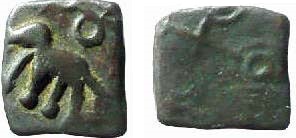
|
Ujjain, anonymous AE 1/ 16 karshapana, elephant type
Weight: 0.51 gm., Diameter: 9x8 mm.
Obv.: Elephant to left with Ujjain symbol above.
Rev.: Double-orbed Ujjain symbol.
Reference: Pieper 353 (plate specimen)
|
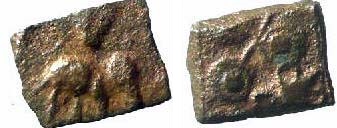
|
Ujjain, anonymous AE 1/ 12 karshapana, elephant type
Weight: 0.67 gm., Diameter: 9x7 mm.
Obv.: Elephant to right with taurine above.
Rev.: Ujjain symbol with dot in each orb, shrivatsa in field.
Reference: Pieper 355 (plate specimen)
|
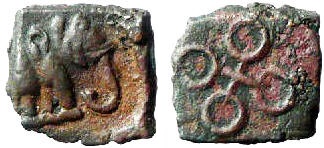
|
Ujjain, anonymous AE 1/ 12 karshapana, elephant type
Weight: 0.69 gm., Diameter: 9x8 mm.
Obv.: Elephant to right.
Rev.: Ujjain symbol.
Reference: Pieper 357 (plate specimen)
|

|
Ujjain, anonymous AE 1/ 12 karshapana, elephant type
Weight: 0.75 gm., Diameter: 10x9 mm.
Obv.: Elephant to right.
Rev.: Ujjain symbol with a dot in each orb.
Reference: Pieper 358 (plate specimen)
|

|
Ujjain, anonymous AE 1/6 karshapana, elephant type
Weight: 1.38 gm., Diameter: 10x10 mm.
Obv.: Elephant to right with raised trunk, Ujjain symbol and taurine
above the elephant; svastika on right bottom.
Rev.: Ujjain symbol with a dot in each orb and alternating taurines and
svastikas in the angles.
Reference: Pieper 359 (plate specimen)
|

|
Ujjain, anonymous AE 1/6 karshapana, elephant type
Weight: 1.45 gm., Diameter: 10x9 mm.
Obv.: Elephant to right with svastika, taurine and Indradhvaja above.
Rev.: Ujjain symbol.
Reference: Pieper 360 (plate specimen)
|

|
Ujjain, anonymous AE 1/4 karshapana, elephant type
Weight: 2,54 gm., Diameter: 15x14 mm.
Obv.: Elephant to right with taurine on left and Indradhvaja on right;
river at the bottom; fish-tank and Ujjain symbol on top.
Rev.: Ujjain symbol.
Reference: Pieper 361 (plate specimen)
|

|
Ujjain, anonymous AE 3/8 karshapana, elephant type
Weight: 3.75 gm., Diameter: 16x14 mm.
Obv.: Elephant with raised trunk to right with chakra on top left;
(railed) tree on right.
Rev.: Ujjain symbol with a taurine in each angle.
Reference: Pieper 362 (plate specimen)
|
 |
A most dynamic depiction of outstanding artistic merit illustrating the unrivalled strength and power of the elephant.
|

|
Ujjain, anonymous AE 1/2 karshapana, elephant type.
Weight: 4.65 gm., Diameter: 14x14 mm.
Obv.: Elephant to right with chakra and Ujjain symbol above; railed tree
on right; river at the bottom.
Rev.: Ujjain symbol with shrivatsa in each orb.
Reference: Pieper 364 (plate specimen)
|

|
Ujjain, inscribed civic AE 1/2 karshapana, civic issue
Weight: 4.97 gm., Diameter: 14 mm.
Obv.: Elephant to right; Ujjain symbol above.
Rev.: Brahmi legend 'ujeniya'; above the legend, chakra on left and footprint on
right; river at the bottom
Reference: Pieper 402 (plate specimen)
|
 |
A rare specimen of
the civic type of the Ujjaini coinage with the name of the city
inscribed in bold Brahmi letters. The type is one example among a
number of other civic coins of the Narmada valley which are inscribed
in the name of the respective city.
|
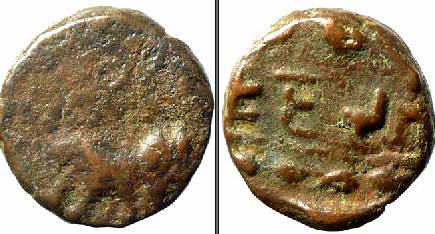
|
Ujjain, inscribed civic AE 3/8 karshapana, civic issue
Weight: 3.67 gm., Diameter: 13 mm.
As previous specimen with complete legend.
Reference: Pieper 403 (plate specimen)
|
 |
UJJAIN, lion types
|

|
Ujjain, anonymous AE 1/16 karshapana, lion type
Weight: 0.54 gm., Diameter: 8 mm.
Obv.: Lion satnding to right, Ujjain symbol on right.
Rev.: Ujjain symbol.
Reference: Pieper 367 (plate specimen)
|
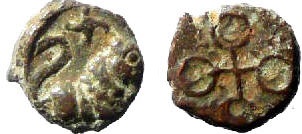
|
Ujjain, anonymous AE 1/12 karshapana, lion type
Weight: 0.73 gm., Diameter: 9 mm.
Obv.: Lion to right, svastika above.
Rev.: Double-orbed Ujjain symbol.
Reference: Pieper 368 (plate specimen)
|
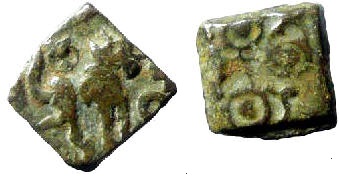
|
Ujjain, anonymous AE 1/12 karshapana, lion type
Weight: 0.81 gm., Diameter: 9x8 mm.
Obv.: Lion standing to right, Ujjain symbol on right.
Rev.: Dotted Ujjain symbol with a triskeles in each angle.
Reference: Pieper 370 (plate specimen)
|
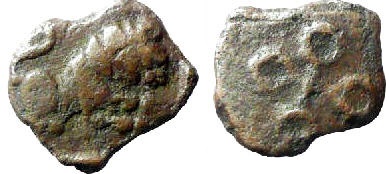
|
Ujjain, anonymous AE 1/8 karshapana, lion type
Weight: 0.89 gm., Diameter: 11x9 mm.
Obv.: Lion resting to right.
Rev.: Ujjain symbol.
Reference: Pieper 371 (plate specimen)
|
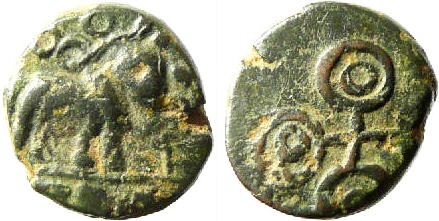
|
Ujjain, anonymous AE 3/8 karshapana, lion type
Weight: 3.54 gm., Diameter: 13 mm.
Obv. Lion standing to right, Ujjain symbol above, railed tree on right,
river at the bottom.
Rev.: Double-orbed Ujjain symbol.
Reference: Pieper 374 (plate specimen)
|
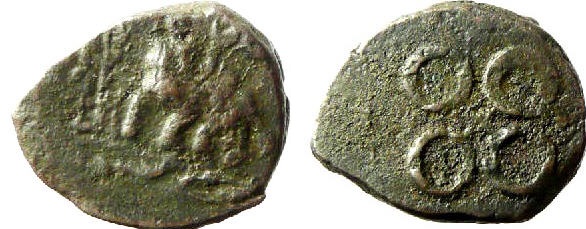
|
Ujjain, anonymous AE 1/2 karshapana, lion type
Weight: 4.93 gm., Diameter: 14 mm.
Obv.: Lion standing to left, Ujjain symbol above, railed tree on left,
river at the bottom.
Rev.: Ujjain symbol.
Reference: Pieper 373 (plate specimen)
|
 |
UJJAIN, other animal types
|

|
Ujjain, anonymous AE 1/6 karshapana, horse type
Weight: 1.35 gm., Diameter: 9x9 mm.
Obv.: Horse to right, horizontally placed railed tree above, vase on right.
Rev.: Ujjain symbol with svastika in each orb.
Reference: Pieper 338 (plate specimen)
|

|
Ujjain, anonymous AE 1/2 karshapana, horse type
Weight: 5.00gm., Diameter: 20x15 mm.
Obv.: Horse to right between railed tree on left and chakra on right;
on top from left to right Ujjain symbol, Indradhvaja (and shrivatsa);
river at the bottom.
Rev.: Double-orbed Ujjain symbol.
Reference: Pieper 347
|

|
Ujjain, anonymous AE 1 karshapana, horse type
Weight: 9.04 gm., Diameter: 20x15 mm.
Obv.: Horse to right, horizontally placed railed tree above the animal and
Ujjain symbol below; river on the left and svastika between two
taurines on the right.
Rev.: Ujjain symbol with alternating svastikas and taurines in its corners.
Reference: Pieper 348 (plate specimen)
|
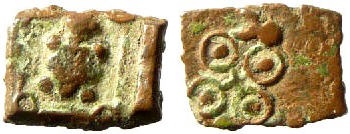
|
Ujjain, anonymous AE 1/12 karshapana, tortoise type
Weight: 0.79 gm., Diameter: 9x7 mm.
Obv.: Tortoise in square frame/tank with a crescent at each angle.
Rev.: Dotted Ujjain symbol, one additional taurine in field.
Reference: Pieper 375 (plate specimen)
|
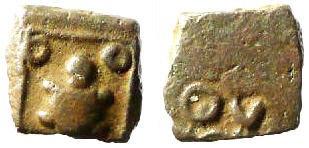
|
Ujjain, anonymous AE 1/8 karshapana, tortoise type
Weight: 0.94 gm., Diameter: 8x8 mm.
Obv.: Tortoise in square frame/ tank with a circle at each angle.
Rev.: Ujjain symbol with additional taurine in field.
Reference: Pieper 376 (plate specimen)
|
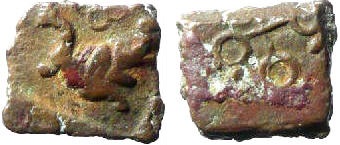
|
Ujjain, anonymous AE 1/8 karshapana, makara type
Weight: 1.17 gm., Diameter: 10x8 mm.
Obv.: Makara to right in form of an aquatic creature with fishtail and
head of an elephant; Ujjain symbol at top.
Rev.: Ujjain symbol with a dot in each angle.
Reference: Pieper 366 (plate specimen)
|
 |
The makara is the vahana (mount) of Ganga, the goddess of the river Ganges,
and of the sea-god Varuna. Its frontal part is that of a terrestrial animal, its hind part
that of a sea-creature. The depiction of a creature with fish-tail and elephant's head,
like on this coin, is frequently used in depictions of a makara.
|
 |
 |
 |
Other Ujjain pages: page 1 ,
page 2 , and
page 4
|
|
|